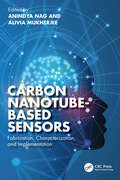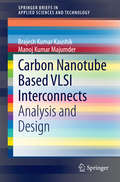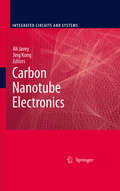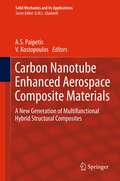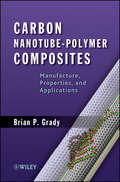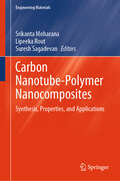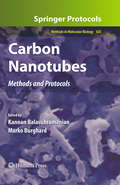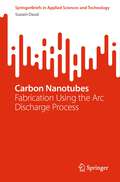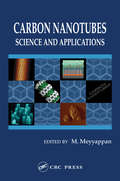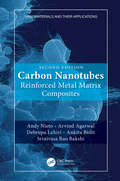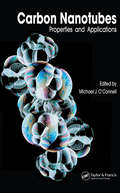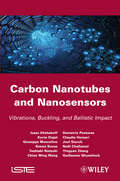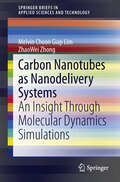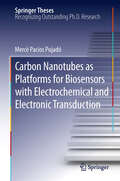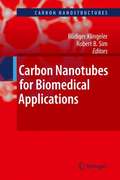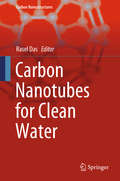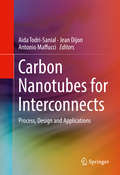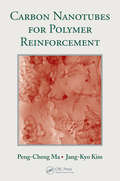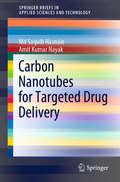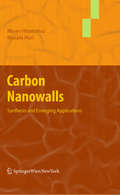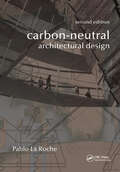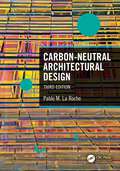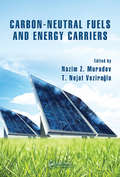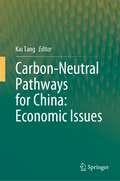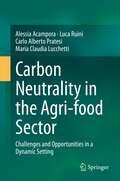- Table View
- List View
Carbon Nanotube-Based Sensors: Fabrication, Characterization, and Implementation
by Anindya Nag Alivia MukherjeeCarbon Nanotube-Based Sensors: Fabrication, Characterization, and Implementation highlights the latest research and developments on carbon nanotubes (CNTs) and their applications in sensors and sensing systems. It offers an overview of CNTs, including their synthesis, functionalization, characterization, and toxicology. It then delves into the fabrication and various applications of CNT-based sensors.FEATURES Defines the significance of different forms of CNT-based sensors synthesized for diverse engineering applications and compares the feasibility of their generation Helps readers evaluate different types of fabrication techniques to generate CNTs and their subsequent sensing Discusses fabrication of low-cost, efficient CNTs-based sensors that can be used for diverse applications and sheds light on synthesis methods for a range of printing techniques Highlights challenges and advances in security-related issues using CNTs-based sensors This book is aimed at researchers in the fields of materials and electrical engineering who are interested in the development of sensor technology for industrial, biomedical, and related applications.
Carbon Nanotube Based VLSI Interconnects: Analysis and Design (SpringerBriefs in Applied Sciences and Technology)
by Brajesh Kumar Kaushik Manoj Kumar MajumderThe brief primarily focuses on the performance analysis of CNT based interconnects in current research scenario. Different CNT structures are modeled on the basis of transmission line theory. Performance comparison for different CNT structures illustrates that CNTs are more promising than Cu or other materials used in global VLSI interconnects. The brief is organized into five chapters which mainly discuss: (1) an overview of current research scenario and basics of interconnects; (2) unique crystal structures and the basics of physical properties of CNTs, and the production, purification and applications of CNTs; (3) a brief technical review, the geometry and equivalent RLC parameters for different single and bundled CNT structures; (4) a comparative analysis of crosstalk and delay for different single and bundled CNT structures; and (5) various unique mixed CNT bundle structures and their equivalent electrical models.
Carbon Nanotube Electronics (Integrated Circuits and Systems)
by Ali Javey Jing KongThis book provides a complete overview of the field of carbon nanotube electronics. It covers materials and physical properties, synthesis and fabrication processes, devices and circuits, modeling, and finally novel applications of nanotube-based electronics. The book introduces fundamental device physics and circuit concepts of 1-D electronics. At the same time it provides specific examples of the state-of-the-art nanotube devices.
Carbon Nanotube Enhanced Aerospace Composite Materials: A New Generation of Multifunctional Hybrid Structural Composites (Solid Mechanics and Its Applications #188)
by A. Paipetis V. KostopoulosThe well documented increase in the use of high performance composites as structural materials in aerospace components is continuously raising the demands in terms of dynamic performance, structural integrity, reliable life monitoring systems and adaptive actuating abilities. Current technologies address the above issues separately; material property tailoring and custom design practices aim to the enhancement of dynamic and damage tolerance characteristics, whereas life monitoring and actuation is performed with embedded sensors that may be detrimental to the structural integrity of the component. This publication explores the unique properties of carbon nanotubes (CNT) as an additive in the matrix of Fibre Reinforced Plastics (FRP), for producing structural composites with improved mechanical performance as well as sensing/actuating capabilities. The successful combination of the CNT properties and existing sensing actuating technologies leads to the realization of a multifunctional FRP structure. The current volume presents the state of the art research in this field. The contributions cover all the aspects of the novel composite systems, i.e. modeling from nano to macro scale, enhancement of structural efficiency, dispersion and manufacturing, integral health monitoring abilities, Raman monitoring, as well as the capabilities that ordered carbon nanotube arrays offer in terms of sensing and/or actuating in aerospace composites.
Carbon Nanotube-Polymer Composites: Manufacture, Properties, and Applications
by Brian P. GradyThe accessible compendium of polymers in carbon nanotubes (CNTs) Carbon nanotubes (CNTs)—extremely thin tubes only a few nanometers in diameter but able to attain lengths thousands of times greater—are prime candidates for use in the development of polymer composite materials. Bringing together thousands of disparate research works, Carbon Nanotube-Polymer Composites: Manufacture, Properties, and Applications covers CNT-polymers from synthesis to potential applications, presenting the basic science and engineering of this dynamic and complex area in an accessible, readable way. Designed to be of use to polymer scientists, engineers, chemists, physicists, and materials scientists, the book covers carbon nanotube fundamentals to help polymer experts understand CNTs, and polymer physics to help those in the CNT field, making it an invaluable resource for anyone working with CNT-polymer composites. Detailed chapters describe the mechanical, rheological, electrical, and thermal properties of carbon nanotube-polymer composites. Including a glossary that defines key terms, Carbon Nanotube-Polymer Composites is essential reading for anyone looking to gain a fundamental understanding of CNTs and polymers, as well as potential and current applications, including electronics (shielding and transparent electrodes), flame retardants, and electromechanics (sensors and actuators), and their challenges.
Carbon Nanotube-Polymer Nanocomposites: Synthesis, Properties, and Applications (Engineering Materials)
by Suresh Sagadevan Srikanta Moharana Lipeeka RoutThis book presents the latest advancements in various synthetic techniques, properties, characterization, and efficient applications of CNT-polymer nanocomposites. The preparation, properties, characterization, and applications of these technologically intriguing new materials are discussed in detail. The book covers a wide range of topics from the fundamentals of carbon nanotubes, their reinforced polymer nanocomposites and their applications in various fields including energy storage, 3D printing, electronics, aerospace and coatings, and environmental and bio-medical/bioengineering. It is a good resource for students, material scientists, and professionals interested in the synthesis, properties, characteristics, and cutting-edge applications of carbon nanotubes-polymer nanocomposites.
Carbon Nanotubes: Methods and Protocols (Methods in Molecular Biology #625)
by Kannan Balasubramanian Marko BurghardDue to their rare combination of high chemical stability, exceptional optical and electrical properties, high surface-to-volume ratio, and high aspect ratio, carbon nanotubes (CNTs) have made an enormous impact on materials science, molecular biology, biomedicine, and bioanalytical chemistry. Carbon Nanotubes: Methods and Protocols provides reliable, consistent protocols on the application of CNTs in molecular biology-related fields. These are of vital importance, as the commercially available CNTs differ in purity, agglomeration state, as well as length and diameter distribution, all of which have a profound influence on the dispersability and surface properties of the tubes. The volume contains detailed sections on functionalization, toxicity, trafficking, scaffolds, and biosensors, provided by expert researchers from various fields. Written in the highly successful Methods in Molecular BiologyTM series format, chapters include introductions to their respective topics, lists of the necessary materials and reagents, step-by-step, readily reproducible laboratory protocols, and notes on troubleshooting and avoiding known pitfalls. Authoritative and cutting-edge, Carbon Nanotubes: Methods and Protocols serves to contribute to the achievement of common standards and helps researchers to avoid discrepancies in future biology-related CNT studies.
Carbon Nanotubes: Fabrication Using the Arc Discharge Process (SpringerBriefs in Applied Sciences and Technology)
by Suzairi DaudThis book highlights a comprehensive understanding of the fabrication and growth of carbon nanostructures via the arc discharge process. Its content is designed to benefit academicians, students, researchers, scientists, and readers who are interested in gaining knowledge in this area. The book presents findings on the arc discharge process and provide detailed information on the optimal state and energy of carbon ions in arc discharge plasma, observed under different pressures and ambient environments. The contents presented here can be applied to enhance the performance of various applications. This book provides a valuable resource for those looking to gain a deeper understanding of the arc discharge process and the growth of carbon nanostructures, with practical applications in industries such as electronics, semiconductors, and energy storage.
Carbon Nanotubes: Science and Applications
by M. MeyyappanCarbon nanotubes, with their extraordinary mechanical and unique electronic properties, have garnered much attention in the past five years. With a broad range of potential applications including nanoelectronics, composites, chemical sensors, biosensors, microscopy, nanoelectromechanical systems, and many more, the scientific community is more moti
Carbon Nanotubes: Reinforced Metal Matrix Composites (Nanomaterials and their Applications)
by Andy Nieto Arvind Agarwal Debrupa Lahiri Ankita Bisht Srinivasa Rao BakshiThis discovery of carbon nanotubes (CNT) three decades ago ushered in the technological era of nanotechnology. Among the most widely studied areas of CNT research is their use as structural reinforcements in composites. This book describes the development of CNT reinforced metal matrix composites (CNT-MMCs) over the last two decades. The field of CNT-MMCs is abundant in fundamental science, rich in engineering challenges and innovations and ripe for technological maturation and commercialization. The authors have sought to present the current state of the-art in CNT-MMC technology from their synthesis to their myriad potential end-use applications. Specifically, topics explored include: • Advantages, limitations, and evolution of processing techniques used to synthesize and fabricate CNT-MMCs • Emphasizes dispersion techniques of CNTs in metallic systems, a key challenge to the successful and widespread implementation of CNT-MMCs. Methods for quantification and improved control of CNT distributions are presented • Methods for quantification and improved control of CNT distributions are presented • Characterization techniques uniquely suited for charactering these nanoscale materials and their many chemical and physical interactions with the metal matrix, including real-time in-situ characterization of deformation mechanisms • Electron microscope images from premier studies enrich discussions on micro-mechanical modeling, interfacial design, mechanical behavior, and functional properties • A chapter is dedicated to the emergence of dual reinforcement composites that seek to enhance the efficacy of CNTs and lead to material properties by design This book highlights seminal findings in CNT-MMC research and includes several tables listing processing methods, associated CNT states, and resulting properties in order to aid the next generation of researchers in advancing the science and engineering of CNT-MMCs. In addition, a survey of the patent literature is presented in order to shed light on what the first wave of CNT-MMC commercialization may look like and the challenges that will have to be overcome, both technologically and commercially.
Carbon Nanotubes: Properties and Applications
by Michael J. O’ConnellSince their discovery more than a decade ago, carbon nanotubes (CNTs) have held scientists and engineers in captive fascination, seated on the verge of enormous breakthroughs in areas such as medicine, electronics, and materials science, to name but a few. Taking a broad look at CNTs and the tools used to study them, Carbon Nanotubes: Properties and Applications comprises the efforts of leading nanotube researchers led by Michael O’Connell, protégé of the late father of nanotechnology, Richard Smalley. Each chapter is a self-contained treatise on various aspects of CNT synthesis, characterization, modification, and applications. The book opens with a general introduction to the basic characteristics and the history of CNTs, followed by discussions on synthesis methods and the growth of “peapod” structures. Coverage then moves to electronic properties and band structures of single-wall nanotubes (SWNTs), magnetic properties, Raman spectroscopy of electronic and chemical behavior, and electromechanical properties and applications in NEMS (nanoelectromechanical systems). Turning to applications, the final sections of the book explore mechanical properties of SWNTs spun into fibers, sidewall functionalization in composites, and using SWNTs as tips for scanning probe microscopes. Taking a fresh look at this burgeoning field, Carbon Nanotubes: Properties and Applications points the way toward making CNTs commercially viable.
Carbon Nanotubes and Nanosensors: Vibration, Buckling and Balistic Impact (Wiley-iste Ser.)
by Isaac Elishakoff Kevin Dujat Giuseppe Muscolino Simon Bucas Toshiaki Natsuki Chien Ming Wang Demetris Pentaras Claudia Versaci Joel Storch Noël Challamel Yingyan Zhang Guillaume GhyselinckThe main properties that make carbon nanotubes (CNTs) a promising technology for many future applications are: extremely high strength, low mass density, linear elastic behavior, almost perfect geometrical structure, and nanometer scale structure. Also, CNTs can conduct electricity better than copper and transmit heat better than diamonds. Therefore, they are bound to find a wide, and possibly revolutionary use in all fields of engineering.The interest in CNTs and their potential use in a wide range of commercial applications; such as nanoelectronics, quantum wire interconnects, field emission devices, composites, chemical sensors, biosensors, detectors, etc.; have rapidly increased in the last two decades. However, the performance of any CNT-based nanostructure is dependent on the mechanical properties of constituent CNTs. Therefore, it is crucial to know the mechanical behavior of individual CNTs such as their vibration frequencies, buckling loads, and deformations under different loadings.This title is dedicated to the vibration, buckling and impact behavior of CNTs, along with theory for carbon nanosensors, like the Bubnov-Galerkin and the Petrov-Galerkin methods, the Bresse-Timoshenko and the Donnell shell theory.
Carbon Nanotubes as Nanodelivery Systems: An Insight Through Molecular Dynamics Simulations (SpringerBriefs in Applied Sciences and Technology)
by Melvin Choon Lim Zhaowei ZhongThis book showcases the application of carbon nanotubes as nanodelivery systems for copper atoms, using molecular dynamics simulations as a means of investigation. The nanodelivery system of the carbon nanotube presents the possible usage of the carbon structure in many areas in the future. This book is comprehensive and informative, and serves as a guide for any reader who wishes to perform a molecular dynamics simulation of his own and to conduct an analytical study of a molecular system.
Carbon Nanotubes as Platforms for Biosensors with Electrochemical and Electronic Transduction (Springer Theses)
by Mercè Pacios PujadóThe thesis by Mercè Pacios exploits properties of carbon nanotubes to design novel nanodevices. The prominent electrochemical properties of carbon nanotubes are used to design diverse electrode configurations. In combination with the chemical properties and (bio)functionalization versatility, these materials prove to be very appropriate for the development of electrochemical biosensors. Furthermore, this work also evaluates the semiconductor character of carbon nanotubes (CNT) for sensor technology by using a field effect transistor configuration (FET). The CNT-FET device has been optimized for operating in liquid environments. These electrochemical and electronic CNT devices are highly promising for biomolecule sensing and for the monitoring of biological processes, which can in the future lead to applications for rapid and simple diagnostics in fields such as biotechnology, clinical and environmental research.
Carbon Nanotubes for Biomedical Applications (Carbon Nanostructures)
by Rüdiger Klingeler Robert B. SimThis book explores the potential of multi-functional carbon nanotubes for biomedical applications. It combines contributions from chemistry, physics, biology, engineering, and medicine. The complete overview of the state-of-the-art addresses different synthesis and biofunctionalisation routes and shows the structural and magnetic properties of nanotubes relevant to biomedical applications. Particular emphasis is put on the interaction of carbon nanotubes with biological environments, i.e. toxicity, biocompatibility, cellular uptake, intracellular distribution, interaction with the immune system and environmental impact. The insertion of NMR-active substances allows diagnostic usage as markers and sensors, e.g. for imaging and contactless local temperature sensing. The potential of nanotubes for therapeutic applications is highlighted by studies on chemotherapeutic drug filling and release, targeting and magnetic hyperthermia studies for anti-cancer treatment at the cellular level.
Carbon Nanotubes for Clean Water (Carbon Nanostructures Ser.)
by Rasel DasThis book presents carbon nanotubes as a potential material for the development of new waste water treatment technologies. Reviews on adsorption, catalysis, membrane, filtration and desinfection methods are provided. A special chapter presents the use of carbon nanotubes to sense and monitor water pollutants. The text underlies each technology and process as well as the current commercialization efforts. Research gaps are highlighted at the end with links to further reading material in the field.
Carbon Nanotubes for Interconnects: Process, Design and Applications
by Antonio Maffucci Aida Todri-Sanial Jean DijonThis book provides a single-source reference on the use of carbon nanotubes (CNTs) as interconnect material for horizontal, on-chip and 3D interconnects. The authors demonstrate the uses of bundles of CNTs, as innovative conducting material to fabricate interconnect through-silicon vias (TSVs), in order to improve the performance, reliability and integration of 3D integrated circuits (ICs). This book will be first to provide a coherent overview of exploiting carbon nanotubes for 3D interconnects covering aspects from processing, modeling, simulation, characterization and applications. Coverage also includes a thorough presentation of the application of CNTs as horizontal on-chip interconnects which can potentially revolutionize the nanoelectronics industry. This book is a must-read for anyone interested in the state-of-the-art on exploiting carbon nanotubes for interconnects for both 2D and 3D integrated circuits.
Carbon Nanotubes for Polymer Reinforcement
by Peng-Cheng Ma Jang-Kyo KimDiscovered in the twentieth century, carbon nanotubes (CNT) were an integral part of science and industry by the beginning of the twenty first century, revolutionizing chemistry, physics, and materials science. More recent advances in carbon nanotube production methods have resulted in a tremendous push to incorporate CNTs into polymer matrices. Al
Carbon Nanotubes for Targeted Drug Delivery (SpringerBriefs in Applied Sciences and Technology)
by Md Saquib Hasnain Amit Kumar NayakThis book provides a detailed introduction to carbon nanotubes (CNTs) for targeted drug delivery. After a brief overview of the classification, preparation, and characterization of carbon nanotubes, it focuses on their use in targeted drug delivery. It presents CNTs for brain targeting, ocular targeting, cancer targeting, and lymphatic targeting, as well as antibody therapy. The book also includes chapters on carbon nanotubes for controlled drug delivery, transdermal drug delivery, solubility enhancement, vaccine delivery, gene delivery, and as quantum dots. Last but not least, it addresses the absorption and transportation of CNTs, toxicity and regulatory considerations, as well as clinical trials and the market status of CNTs. The book offers a comprehensive, self-contained reference guide, with all topics covered concisely and with the help of figures, tables and flowcharts.
Carbon Nanowalls: Synthesis and Emerging Applications
by Masaru Hori Mineo HiramatsuRepresenting the first text to cover this exciting new area of research, this book will describe synthesis techniques of CNWs, their characterization and various expected applications using CNWs. Carbon-nanowalls (CNWs) can be described as two-dimensional graphite nanostructures with edges comprised of stacks of plane graphene sheets standing almost vertically on the substrate. These sheets form a wall structure with a high aspect ratio. The thickness of CNWs ranges from a few nm to a few tens of nm. The large surface area and sharp edges of CNWs may prove useful for a number of applications such as electrochemical devices, field electron emitters, storage materials for hydrogen gas, catalyst support. In particular, vertically standing CNWs with a high surface-to-volume ratio, serve as an ideal material for catalyst support for fuel cells and in gas storage materials.
Carbon-Neutral Architectural Design
by Pablo M. La RocheThe energy used to operate buildings is one of the most significant sources of greenhouse gas emissions. While it is possible to reduce emissions through climate-responsive design, many architects are not trained to do this. Filling an urgent need for a design reference in this emerging field, this book describes how to reduce building-related greenhouse gas emissions through appropriate design techniques. It presents strategies to achieve CO2 reductions, with an emphasis on control of energy flows through the building envelope and passive heating and cooling strategies. This new, revised edition is updated throughout, and includes a new chapter on building simulations.
Carbon-Neutral Architectural Design
by Pablo M. La RocheThe energy used to build and operate buildings is a significant source of greenhouse gas emissions. While it is possible to reduce emissions through low-carbon design, many architects are not trained to do this. Filling an urgent need for a design reference in this emerging field, this book describes how to reduce building-related greenhouse gas emissions through appropriate design techniques. It presents strategies to achieve CO2 reductions, with an emphasis on control of energy flows through the building envelope and passive cooling and heating strategies. This new, revised edition is updated throughout and includes a new section on embodied carbon and new chapters on daylighting and nature-based cooling.Features: Adds new chapters on daylighting and nature-based cooling with numerous updates throughout the rest of the chapters Presents strategies, illustrated with examples, for new construction and existing buildings to reduce energy consumption and reduce emissions Explains the origins of CO2 emissions associated with the operation and fabrication of buildings: supplying water, disposing of waste from the building, and proposes strategies to reduce them Covers carbon calculations, thermal comfort, indigenous technology, climate‑responsive design, passive cooling and heating, solar design, air flow analysis, daylighting, building simulation and microclimate design with abundant examples Examines siting/location to design buildings that adapt and mitigate their effect on climate change
Carbon-Neutral Fuels and Energy Carriers (Green Chemistry and Chemical Engineering)
by Nazim Z. Muradov T. Nejat VeziroǧluConcerns over an unstable energy supply and the adverse environmental impact of carbonaceous fuels have triggered considerable efforts worldwide to find carbon-free or low-carbon alternatives to conventional fossil fuels. Carbon-Neutral Fuels and Energy Carriers emphasizes the vital role of carbon-neutral energy sources, transportation fuels, and a
Carbon-Neutral Pathways for China: Economic Issues
by Kai TangThis book provides comprehensive economic analyses on the paths to net-zero for China. It gives a detailed overview of issues and challenges related to carbon neutrality of the global largest emitter which have not been adequately addressed e.g., reduction costs and efficiency of existing actions, the multiple impacts of the newly established carbon market, and the potentials and costs of nature-based solutions such as biophysical sequestration, etc. Studies on China’s carbon reduction have attracted scientists and policymakers from diverse backgrounds. Pursuing a holistic and systematic approach, the book establishes a fundamental framework for this topic, emphasizing the importance of integrated technical-economic-policy analysis. This book will not only be an essential reference to the carbon-neutral progress in China but also will be an outstanding text book on carbon-neutral management. Similarly, this book is expected to attract a great range of readership including undergraduate and postgraduate students, economic and climate specialists, researchers and policymakers in China as well as in overseas.
Carbon Neutrality in the Agri-food Sector: Challenges and Opportunities in a Dynamic Setting
by Alessia Acampora Luca Ruini Carlo Alberto Pratesi Maria Claudia LucchettiThis book deals with the in-depth study of sustainability issues in the agri-food sector. In particular, a critical analysis of the current situation was developed and the future prospects of the sector on the issue of managing the environmental variable and the impacts relating to food production and consumption have been analyzed. Furthermore, the state of implementation and best practices relating to the carbon neutrality model in the agri-food sector were analyzed and models for the development of a new food production system were proposed with particular reference to the reduction of emissions, regeneration of natural resources, the elimination of waste and the reuse of production by-products. The main objectives of the book are to analyze the current situation and trends regarding carbon neutrality schemes and the connection with other greening programs, to identify and analyze the carbon-related labels, their methodology and their conformity assessment mechanisms and to understand possible key drivers for carbon neutrality or low carbon achievements in the agri-food sector.Today companies are acting on climate change pressures implementing carbon-neutral strategies for their brands and products. These frontrunner companies have identified a specific competitive advantage and are exploiting it to become the pioneers and the reference model for the carbon neutral implementation. This book will provide detailed and practical insights on how your organization can take positive action and be part of the global response developing a carbon neutral business.
